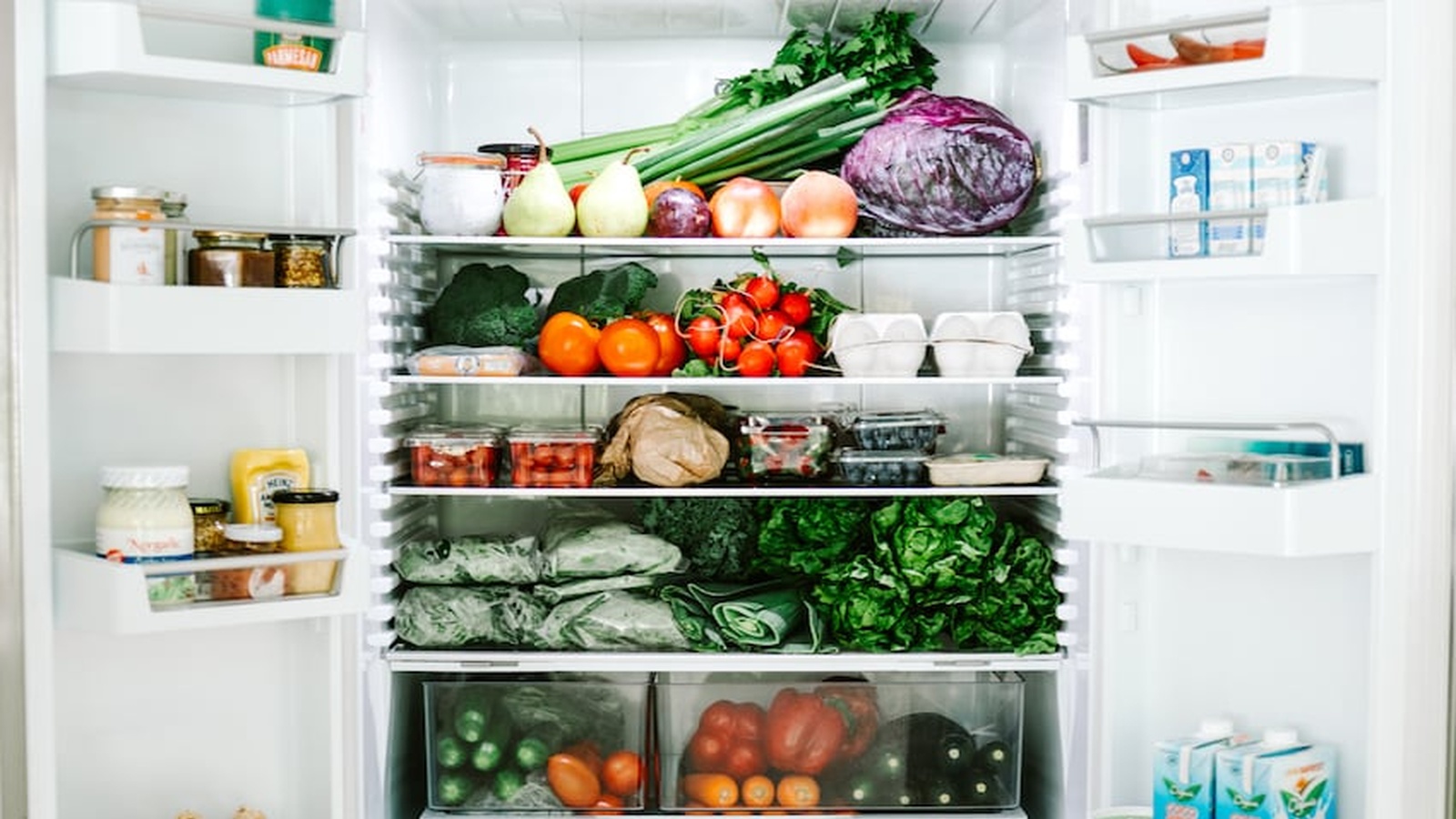From Mason Jars to Fridge Hacks: 11 Ways We Store Our Food
Any foodie will tell you that the key to a kitchen is a handful of simple routines, or ‘hacks’. How you store your food is just as important as the food you buy itself. Whether you’re making the most out of shelf-life, looking to reduce wastage, or trying to save time and space, there’s a few simple rules to follow. It’s nothing that will break the bank or eat up your weekend, but rather that little bit of preparation to make your life infinitely easier. From mason jars to fridge hacks, here are 11 ways we store our food in the Food Matters kitchen.
1. Packageless Pantry
First, go back to basics and start with all the goodness in your pantry. From quinoa to cashews, all of our healthy wholefoods can become a mess if they’re not stored correctly. We love spending time organizing a ‘packageless pantry’. Not only do the uniform jars look beautiful on shelves, but by shopping in bulk and using jars or containers to store your foods you’re reducing unnecessary plastic, saving money on staple foods, and storing them in a way that keeps them fresher for longer. Plus, it’s really fun rearranging beautiful shelves - so you always know where your staples are when you need them, and you’re guaranteed compliments from every dinner guest.
2. Store Root Vegetables In Cool, Dry, Dark Places
While you’re in the pantry, this is one of the best places to store root vegetables. In the cooler, darker corners, keep some baskets, canvas bags, or even large ceramic vessels to store things like potatoes, pumpkins, and onions. This will prevent them from sprouting or getting too weathered by harsh environments.
3. Invest In Spice Jars
Leaving spices in their little pouches from the store is one of the fastest ways to spill them, lose them, and create a mess in your kitchen. Spice jars are an inexpensive, but lifesaving investment when it comes to preserving the nutritional integrity of the healing herbs and spices. Plus, when you’re creating delicious dishes in the kitchen, it makes them that much easier to find.
4. Fresh Herb Storage
When dealing with fresh herbs, rather than dried, if they’re not coming fresh from the garden, store them for longevity. There’s a couple of ways we do this, depending on where we have room in our fridge, but either way prevents them from going limp, flavorless, and sad looking. The easiest way is to fill a glass jar or tumbler part-way with cold water, and place your bunch of herbs in there like a bouquet of flowers so that the roots and stems submerged in water. Then, wrap the leaves in re-usable plastic (we like to re-use sandwich bags) and store them in the refrigerator. Alternatively, you can lightly spritz them with water, roll them in a damp paper towel, and store them in your vegetable crisper drawer.
5. Salad Spinners for Green Leaves
To keep salad leaves fresh, you can use the same wet paper towel hack that you would with herbs, or you can keep them ready to go at a moment’s notice. One of the best kitchen gadgets is a compact salad spinner. The ventilated basket stops any produce from going limp or rotten to quick, and whenever it needs a freshen up or wash, you can rinse and spin with a fuss-free approach. Plus, the sealed lid keeps your greens fresher for longer and they’re ready to put on the table at dinnertime.
6. Prepare Your Produce for Longevity
It’s easy enough after your weekly trip to the market or grocer to get home and attempt to shove your produce wherever there is space. But by dedicating an extra 15-minutes to rotating your fridge contents and getting the new fruits and vegetables ready for the week ahead, you’ll thank yourself infinitely when it comes to busy dinners throughout the week. Start by pulling out any left-over produce from last week. Then take your fresh foods and wash, chop, and prep them if need be, before putting them in containers to be on-hand for the week ahead. Once they’re good to go, make sure your older produce is still okay to eat (compost if not) and place it back on top - this means you’ll reach for the food that needs using first.
7. Glass Containers & Reusable Jars
Speaking of containers, making sure you have ample containers is the key to keeping your fridge organized. They can be a relatively inexpensive set, but they’ll make your life easier. Glass or ceramic containers that can stack on each other are the gold standard, as you can be sure no chemicals in the plastic are leaching into your food while making the most of space - plus they’re much sturdier and are great for storing leftovers too. Alternatively, any reusable jars always make great containers for prep day foods such as quinoa, or individual leftover portions of soup - if you’re not already using all of the jars in your packageless pantry!
8. Choose Reusable Food Covers
If you’re looking for ways to make your kitchen more sustainable, consider switching your cling film out for a washable, reusable alternative. Silicone food covers and beeswax wraps are readily available online, and while they’re initially more expensive, they last forever so will save you money in the long run! And if you’re crafty or creative, you can easily make your own beeswax wraps at home with your favorite fabrics.
9. Secrets of Mushroom Storage
Most of your food should be stored in individual containers or the vegetable crisper, but there’s an exception to the rule. Mushrooms last better when kept in the brown paper bag that they come in from the store. Don’t put them in the crisper drawer either, but rather the shelf just above. This will ensure the mushrooms have the right climate to stay fresher for longer.
10. Spring Clean Your Shelves
When you get on a roll, it’s easy to want to get everything done at once. So set aside one day a month to spring clean your fridge and shelves. The task may seem mammoth to begin with, but if you keep on top of it regularly it can be done in as little as 5-minutes. The best place to begin is the shelves in your fridge door; how often to special sauces or random condiments sit here for six months or more gathering dust and mold? Then take this approach for the rest of the fridge, before moving onto the pantry. This way, there’s room for fresh produce and delicious meals, every day of the week. Another good way to keep on top of it is checking your vegetable crisper daily to make sure you’re using all of the food so none is going to waste. Then, if you’re feeling up to it - move onto the freezer...
11. Freeze Foods In Individual Portions
While you’re in the freezer, it’s good to employ a handful of life hacks to make sure you’re getting the most out of this limited space. When making food in bulk, or deciding to freeze any leftovers, place it in smaller containers to freeze in individual portions. That way, you only have to defrost what you need each time. You can use kitchen tools like muffin tins to freeze big batches of pesto for smaller servings or ice cube trays to freeze single-serve portions of lemon juice. Also, try to keep food in like-spaces; leftovers in one section, meats in another, fruits for smoothies in one area, and sweet treats somewhere else - it’ll make it that much easier when trying to find what you need (and remembering to top up when you run out). Then, when defrosting foods like leftover lasagne or individually portioned fish fillets, pull them out of the freezer the night before and place in the refrigerator to defrost in time.
Kitchens don’t have to be a stressful or chaotic space. Sometimes all you need is some new ideas and an extra half-hour after your weekly shop. Start with one new approach each week, or each time you run out of a dry ingredient, find a new jar, and begin filling it up from the bulk buy section. In a few short weeks, you’ll be able to find foods easier, reduce your food waste, and move around the kitchen with ease.
If you haven’t already, join our free global challenge at www.GetOffTheGluten.com to receive daily recipes & health tips, access to our private group for support and inspiration, plus before and after testing to track your progress in key areas of your life such as weight, sleep, bloating, skin-conditions, mental health and more!










